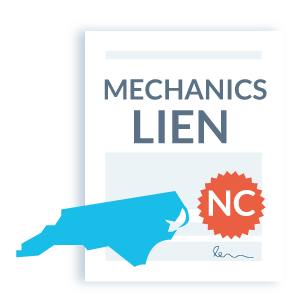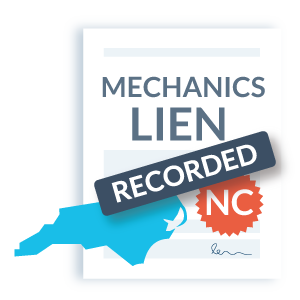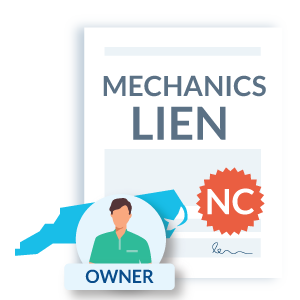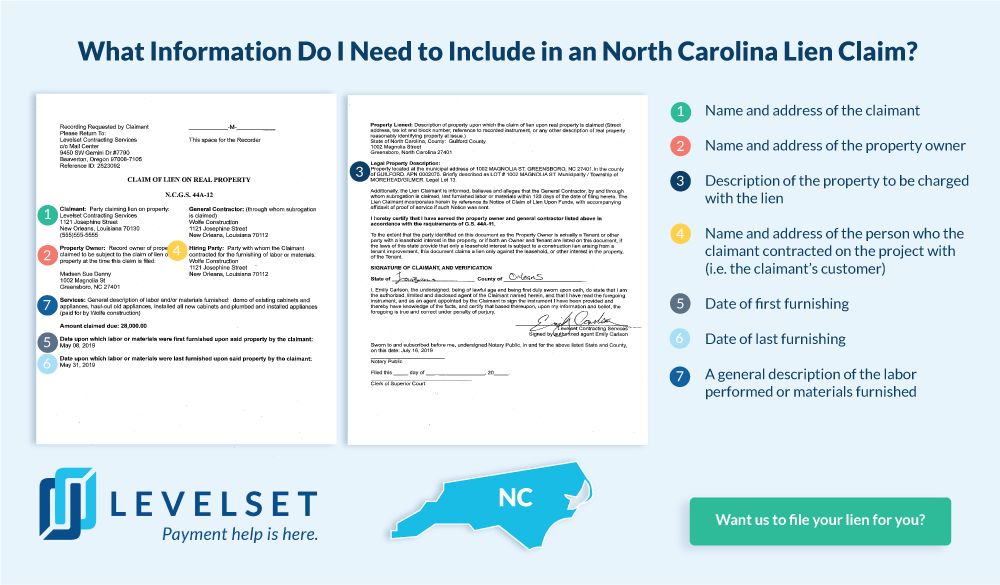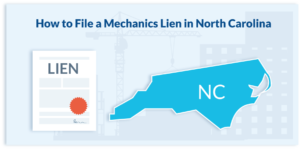
Contractors, subs, and suppliers that are hard at work in the construction business are exposed to the risk of slow payments and non-payments on an almost daily basis. If you are unpaid for construction work in North Carolina, you likely have the right to file a mechanics lien.
The mechanics lien process can be complicated and confusing. This guide will introduce you to the three types of mechanics liens in North Carolina, and walk you through the steps necessary to file a lien and get paid.
Steps to file a mechanics lien in North Carolina
In North Carolina, a lien claimant has 120 days from the date of last furnishing to complete these 3 steps:
- Fill out a mechanics lien form that meets NC requirements
North Carolina law sets specific guidelines claimants must meet in order to file a lien. You must use a form that meets state requirements, and fill it out completely and accurately.
- File the lien with the county recorder’s office
Record your lien claim with the recorder’s office in the county where the property is located.
- Serve a copy of the lien on the property owner
In order to perfect your lien claim, you must provide a copy of the lien to the property owner. Subcontractors and suppliers must also serve a lien copy on the general contractor as well.
North Carolina Has 3 Different Types of Mechanics Lien
Apparently, North Carolina likes to keep the construction industry on their toes because they have 3 different liens available for use on N.C.-based construction projects. The 3 types are:
1. The Claim of Lien on Real Property
This Claim of Lien on Real Property is for a person who contracts directly with the owner of the property. This can be a general contractor, a separate independent contractor, or a design professional.
This first lien type is what one would generally think of as the classic mechanics lien. And, somewhat confusingly, it is the remedy that a subcontractor in North Carolina is probably the least likely to be able to take advantage of.
Free Form Download: Claim of Lien on Real Property (for GCs)
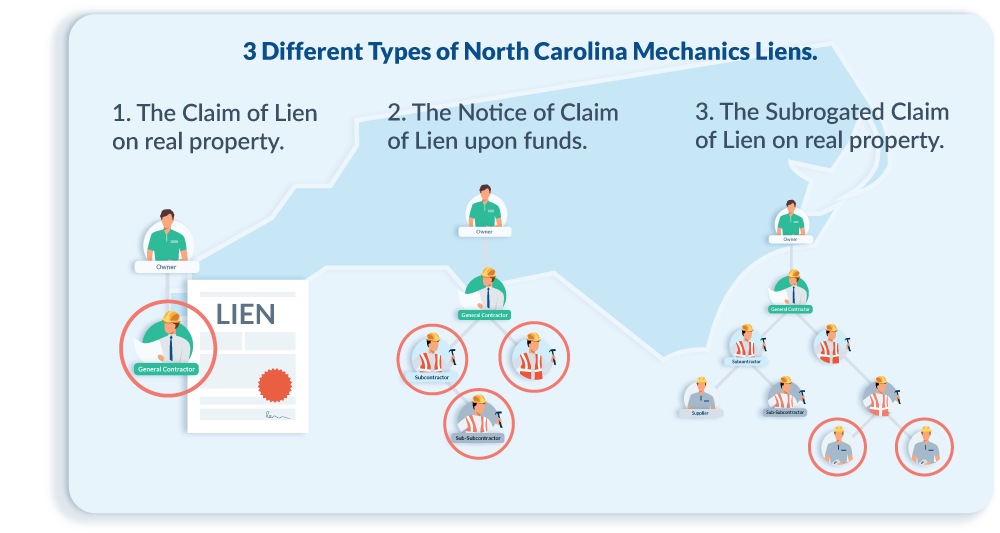
2. The Notice of Claim of Lien Upon Funds
The Notice of Claim of Lien Upon Funds is available to subcontractors (down to third-tier subcontractors) and allows them to have a lien right to any funds owed to the party that contracted with them in the chain of title. In other words, if the owner still owes money to the general contractor, and the owner receives a Notice of Claim of Lien upon Funds by a subcontractor (and the lawsuit to enforce the lien is thereafter properly filed), the owner cannot pay the general contractor until the subcontractor’s lien is extinguished.
Free Form Download: Claim of Lien Upon Funds (for subcontractors and suppliers)
3. The Subrogated Claim of Lien on Real Property
The Subrogated Claim of Lien on Real Property also provides real property lien rights to the subcontractor, to the extent that the party that the subcontractor contracted with (in other words, the party who hired the subcontractor) has lien rights.
Free Form Download: Claim of Lien on Real Property (for subcontractors)
Important Mechanics Lien Considerations for North Carolina Subcontractors
In most cases in North Carolina, a subcontractor does not have the right to claim a lien against the real property. Why is that? In broad terms, the state wanted to provide protection to the subcontractor performing work, but not at the expense of the property owner’s title to the property.
In practical terms, the subcontractor is provided a right against the construction funds (#2 above) rather than against the property itself (sort of like a stop notice) if the certain notices are given. The requirements for a Claim of Lien Against Funds are a little different than options 1 & 3 above – and it is actually sent via certified mail rather than being filed (unless it is attached to a lien under option 1 or 3).
Last but not least, a subcontractor may be entitled to a “subrogation lien” (#3 above). That means that the subcontractor will be able to hitch a ride on the general contractor’s lien and claim the unpaid amount. If this sounds confusing, it is.
A subcontractor is entitled to a lien on the real property in North Carolina, either by himself or through the general contractor, as follows:
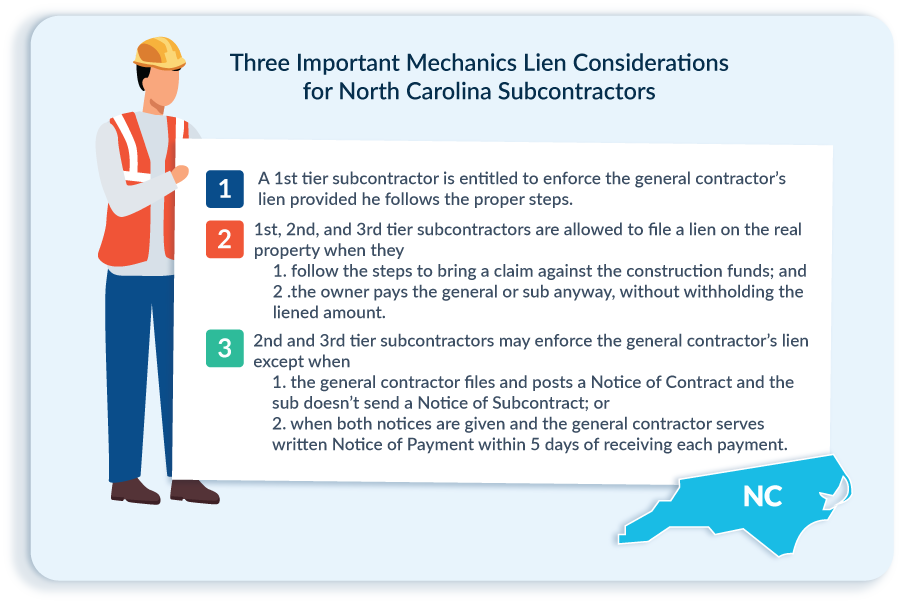
- A 1st tier subcontractor is entitled to enforce the general contractor’s lien provided he follows the proper steps.
- 1st, 2nd, and 3rd tier subcontractors are allowed to file a lien on the real property when they
- follow the steps to bring a claim against the construction funds; and
- the owner pays the general or sub anyway, without withholding the liened amount.
- 2nd and 3rd tier subcontractors may enforce the general contractor’s lien except when
- the general contractor files and posts a Notice of Contract and the sub doesn’t send a Notice of Subcontract; or
- when both notices are given and the general contractor serves written Notice of Payment within 5 days of receiving each payment.
How to File a North Carolina Mechanics Lien — 3 Things You Have to Get Right
Knowing exactly who has the right to file a lien in North Carolina can be a little tricky, so make sure you double check before deciding to file a lien. On the Levelset website, you’ll find North Carolina Lien and Notice FAQs that can provide some help in that department.
There are also various preliminary notice and timing requirements that must be met before you can file a valid North Carolina mechanics lien — you can find answers for both of those in the FAQs as well.
Once you have all of the above requirements in place, you should be ready to file. The steps below will act as a guide for the filing process for liens against real property.
1. What Information Do I Need to Include in an N.C. Lien Claim?
North Carolina has a general lien claim form that should be followed closely. The following information must appear on the lien claim:
- Name and address of the claimant
- Name and address of the property owner
- Description of the property to be charged with the lien
- Name and address of the person who the claimant contracted on the project with (i.e. the claimant’s customer)
- Date of first furnishing
- Date of last furnishing
- A general description of the labor performed or materials furnished
It’s important to get this info right! A North Carolina mechanics lien claim cannot be amended. If there’s an error on the lien form, a claimant may be able to release the flawed lien and refile a corrected one if that can be done before the lien deadline, but that can be a tight squeeze. Therefore, it’s a good idea to double check to make sure all of the information you provide on the claim is accurate.
2. Where Do I Physically File the Mechanics Lien Form in N.C.?
After the lien form is properly filled out, the next step is actually getting it filed. Let’s look at exactly how that’s done:
- File 1 copy in the Office of the Clerk of Superior Court in the county in which the property is located
- The owner must always be served with a copy of the lien claim
- If the claimant is a subcontractor, then the GC must also be served with a copy of the lien claim
In North Carolina, a lien is not perfected until it’s filed with the clerk and served on all required parties. That means all of these steps must be completed before the deadline. The deadline to file a North Carolina mechanics lien is 120 days from the date on which the claimant last furnished labor or materials.
3. What Is the Lien Process Timeline in N.C.?
Finally, it’s important to know how long a lien is good for. A North Carolina mechanics lien only remains enforceable for 180 days after the date of last furnishing labor or materials to the project. That means claimants have about half of a year to negotiate and resolve the dispute before a lien enforcement action becomes necessary. During this time, most lien disputes get resolved! Going to court is usually unnecessary. Of course, sometimes it will be inevitable.
But before filing a lawsuit…
There’s another step claimants can add between filing their lien and making a lien enforcement action. It’s called a Notice of Intent to Foreclose. This document acts as a warning – it states that if payment isn’t made for the lien claim (and made soon), a lien enforcement action will be brought. Everybody hates a lien, but everyone really hates a lawsuit. Thus, a Notice of Intent to Foreclose can really help bring everyone to the negotiating table before a lawsuit becomes necessary.
Whew! Like we’ve said so many times before, lien law can be very confusing! When a contractor, material supplier, or another participant on a construction project is having a problem with getting paid the money they’ve earned, they should think of a mechanics lien as a last resort. But that doesn’t mean that filing a lien isn’t sometimes called for.
In fact, a mechanics lien is arguably one of the most powerful tools when it comes to getting paid in the construction industry. While it’s almost always better to resolve a dispute without having to file a lien claim, when push comes to shove, it’s important to understand how to leverage the power of a mechanics lien.
Payment Help Is Available for the N.C. Construction Industry
If you need some help getting paid on a project in North Carolina, have no fear — Levelset helps folks just like you get paid every single day. We can help you file a lien or another document immediately, or you can get talk to a real, live human being by clicking on the button below.



